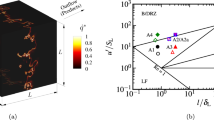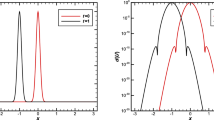Abstract
A rapidly decorrelating velocity field model is used to derive stochastic partial differential equations (SPDE) allowing one to compute the modeled one-point joint probability density function of turbulent reactive scalars. Those SPDEs are shown to be hyperbolic advection/reaction equations. They are dealt with in a generalized sense, so that discontinuities in the scalar fields can be treated. The Eulerian Monte Carlo (EMC) method thus defined is coupled with a RANS solver and applied to the computation of a turbulent premixed methane flame over a backward facing step.
Similar content being viewed by others
References
Carrillo, O., Ibañes, M., Garcia-Ojalvo, J., Casademunt, J., Sancho, J.M.: Intrinsinc noise-induced phase transitions: Beyond the noise interpretation. arxiv:cond-mat, Feb 2003
Gardiner, C.W.: Handbook of Stochastic Methods, 2nd edn. Springer, Berlin Heidelberg New York (1985)
Gilbank, P., Zamuner, B.: Validation du modèle peul+ sur la configuration de marche descendante. Technical Report RT 38/4386/Y, ONERA/DEFA, 1999
Kazantsev, A.P.: Enhancement of a magnetic field by a conducting fluid. Sov. Phys. JETP 26, 1031–1034 (1968)
Kraichnan, R.H.: Small-scale structure of a scalar field convected by turbulence. Phys. Fluids 11, 945–953 (1968)
Magre, P., Collin, G.: Application de la drasc à l’opération A3C. Technical Report R.T.S. ONERA 7/3608 EY, ONERA/DEFA, 1994
Pope, S.B.: Pdf methods for turbulent reactive flows. Pror. Energy Combust. Sci. 27, 119–192 (1985)
Pope, S.B.: Turbulent Flows. Cambridge Univ. Press (2000)
Sabel’nikov, V.A., Soulard, O.: Rapidly decorrelating velocity field model as a tool for solving Fokker–Planck pdf equations of turbulent reactive scalars. Phys. Rev., E 72, 016301 (2005)
Soulard, O.: Approches PDF pour la combustion turbulente : Prise en compte d'un spectre d’échelles turbulentes dans la modélisation du micromélange et élaboration d’une méthode de Monte Carlo Eulérienne. PhD thesis, Univ. Rouen, Jan. 2005
Valiño, L.: A field Monte Carlo formulation for calculating the probability density function of a single scalar in a turbulent flow. Flow Turbul. Combust. 60, 157–172 (1998)
Villermaux, J., Devillon, J.C.: Représentation de la redistribution des domaines de ségrégation dans un fluide par un modèle d’interaction phénoménologique. In: 2nd International Symposium on Chemical Reaction Engineering. Amsterdam, vol. B-1-13, 1972
Westbrook, C.K., Dryer, F.L.: Chemical kinetic modeling of hydrocarbon combustion. Prog. Energy Comb. Sci. 10, 1–57 (1984)
Author information
Authors and Affiliations
Corresponding author
Rights and permissions
About this article
Cite this article
Sabel’nikov, V., Soulard, O. White in Time Scalar Advection Model as a Tool for Solving Joint Composition PDF Equations. Flow Turbulence Combust 77, 333–357 (2006). https://doi.org/10.1007/s10494-006-9049-z
Received:
Accepted:
Published:
Issue Date:
DOI: https://doi.org/10.1007/s10494-006-9049-z




